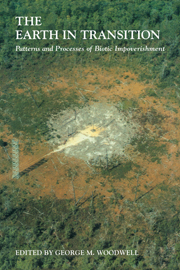Book contents
- Frontmatter
- Contents
- Preface
- Acknowledgments
- List of Contributors
- Part I Global Change and the Patterns of Impoverishment
- Part II Chronic Disturbance and Natural Ecosystems: Forests
- 8 The Restoration of Nonsuch Island as a Living Museum of Bermuda's Precolonial Terrestrial Biome
- 9 Patterns of Impoverishment in Natural Communities: Case History Studies in Forest Ecosystems – New Zealand
- 10 Changes in the Eucalypt Forests of Australia as a Result of Human Disturbance
- 11 Impoverishment in Pacific Island Forests
- 12 Deforestation in Brazilian Amazonia
- 13 Incentives for Sustainable Forest Management
- Part III Chronic Disturbance and Natural Ecosystems: Woodlands, Grasslands, and Tundra
- Part IV Chronic Disturbance and Natural Ecosystems: Aquatic and Emergent Ecosystems
- Part V Conclusion: Steps toward a World That Runs Itself
- Name Index
- Subject Index
8 - The Restoration of Nonsuch Island as a Living Museum of Bermuda's Precolonial Terrestrial Biome
Published online by Cambridge University Press: 24 November 2009
- Frontmatter
- Contents
- Preface
- Acknowledgments
- List of Contributors
- Part I Global Change and the Patterns of Impoverishment
- Part II Chronic Disturbance and Natural Ecosystems: Forests
- 8 The Restoration of Nonsuch Island as a Living Museum of Bermuda's Precolonial Terrestrial Biome
- 9 Patterns of Impoverishment in Natural Communities: Case History Studies in Forest Ecosystems – New Zealand
- 10 Changes in the Eucalypt Forests of Australia as a Result of Human Disturbance
- 11 Impoverishment in Pacific Island Forests
- 12 Deforestation in Brazilian Amazonia
- 13 Incentives for Sustainable Forest Management
- Part III Chronic Disturbance and Natural Ecosystems: Woodlands, Grasslands, and Tundra
- Part IV Chronic Disturbance and Natural Ecosystems: Aquatic and Emergent Ecosystems
- Part V Conclusion: Steps toward a World That Runs Itself
- Name Index
- Subject Index
Summary
Editor's Note: Is it possible to restore an impoverished landscape? What if the landscape is insular, the vegetation has been the victim of goats and other insults compounded with introductions of exotics, including disease, to the point where species have been lost? Is there a possibility of rebuilding a stable community that will have the resilience and vigor of the original? The answer has implications for a globe now wracked regionally by waves of impoverishment without obvious end.
David B. Wingate is one of the few ecologists who has addressed this challenge. He has been successful because he is an extraordinary naturalist with the knowledge, energy, interest, will, and the opportunity to divine the details of the structure, function, and successional relationships of the original vegetation of Bermuda. He tells here the story of how he has reconstructed it on Nonsuch Island. To the extent possible, he has also reestablished the animal community as well, although extinctions and introductions make the reconstruction partial.
The story is unique and delightful. Told here in flowing prose, it is as rich in lessons in ecology as any lifetime could be. And yet, the history of Bermuda is short. It was inundated during the interglacial periods and its biota prior to human settlement in the seventeenth century was limited, even for an oceanic island.
- Type
- Chapter
- Information
- The Earth in TransitionPatterns and Processes of Biotic Impoverishment, pp. 133 - 150Publisher: Cambridge University PressPrint publication year: 1991
- 1
- Cited by



